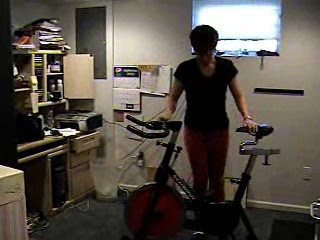Phase 1: Set up proper saddle height, raise or lower saddle to be even with hip to ensure slight flexion of knee at bottom of pedal stroke.
Phase 2: Set up proper seat fore/aft. Move saddle forward or backward so that forward knee, when sitting up in saddle with feet at 3 o'clock and 9 o'clock (knees should be flexed 90 degrees), is in line with where crank arm attaches to pedal to ensure safety of knee during pedal stroke. If you were to drop an imaginary plumb line from top of forward knee to top of foot, line should fall behind shoelaces.
Phase 3: Set up proper handlebar height. Move handle bars up or down to be even with or above saddle to ensure proper positioning of upper body during pedal stroke. When positioned, you should have slight flexion, about 10 degrees, in your elbows when holding handlebars in seated position.
Phase 4: Mount bike, add enough resistance to engage quadriceps and hamstrings so that muscles are working and you have control of pedals.
Phase 5: Slide gluteus maximus back in saddle, lengthen spine, keeping neck in line with spine, contract abdominals posteriorly toward spine to support lower back and stabilize hip flexors.
Phase 6: Depress shoulders away from ears like putting your scapulae in your back pockets, gaze at the road about 1 foot in front of “D” ring.
Phase 7: Flex elbows to create a 10 degree angle and relax grip on handlebars, thumbs should be on top of handle bars with a wrists flexed about 5 degrees.
Phase 8: Keep knees pointed between 2nd and 3rd toes.
Phase 9: Dorsiflex foot (Press heel down) at bottom of pedal stroke, like scraping dog poo off of your shoe.












No comments:
Post a Comment